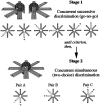Alleviation of a selective age-related relational memory deficit in mice by pharmacologically induced normalization of brain retinoid signaling
- PMID: 11487666
- PMCID: PMC6763177
- DOI: 10.1523/JNEUROSCI.21-16-06423.2001
Alleviation of a selective age-related relational memory deficit in mice by pharmacologically induced normalization of brain retinoid signaling
Abstract
Vitamin A and its derivatives, the retinoids, have been implicated recently in the synaptic plasticity of the hippocampus and might therefore play a role in associated cognitive functions. Acting via transcription factors, retinoids can regulate gene expression via their nuclear receptors [retinoic acid receptors (RARs) and retinoid X receptors]. In a series of experiments, the present study investigated the possible role of age-related downregulation of retinoid-mediated transcription events in the cognitive decline seen in aged mice. We observed that the brain (and hippocampal) levels of retinoid receptors and the expression of specific associated target genes were restored to presenescent (adult) levels in aged mice after acute administration (150 microg/kg, s.c.) of retinoic acid (RA). These effects of RA, however, could be abolished by the coadministration of an RAR antagonist. RA was also demonstrated to alleviate the age-related deficit in the CA1 long-term potentiation efficacy of aged mice in vivo. Moreover, RA was found to alleviate completely the performance deficit of aged mice to the control level in a two-stage spatial discrimination paradigm designed to assess relational memory. This promnesic effect of RA was again susceptible to abolition by RAR antagonist treatment. The parallel molecular, cellular, and behavioral correlates associated with the decrease of retinoid receptor expression and its normalization demonstrated here suggest that the fine regulation of retinoid-mediated gene expression is fundamentally important to optimal brain functioning and higher cognition. Specifically, a naturally occurring dysregulation of retinoid-mediated molecular events might be a potential etiological factor for cognitive deterioration during senescence.
Figures




Similar articles
-
Vitamin A deficiency and relational memory deficit in adult mice: relationships with changes in brain retinoid signalling.Behav Brain Res. 2003 Oct 17;145(1-2):37-49. doi: 10.1016/s0166-4328(03)00099-8. Behav Brain Res. 2003. PMID: 14529804
-
Retinoid hyposignaling contributes to aging-related decline in hippocampal function in short-term/working memory organization and long-term declarative memory encoding in mice.J Neurosci. 2008 Jan 2;28(1):279-91. doi: 10.1523/JNEUROSCI.4065-07.2008. J Neurosci. 2008. PMID: 18171945 Free PMC article.
-
Triiodothyronine administration reverses vitamin A deficiency-related hypo-expression of retinoic acid and triiodothyronine nuclear receptors and of neurogranin in rat brain.Br J Nutr. 2003 Jul;90(1):191-8. doi: 10.1079/bjn2003877. Br J Nutr. 2003. PMID: 12844391
-
Correlations of RAR isoforms and cellular retinoid-binding proteins mRNA levels with retinoid-induced teratogenesis.J Nutr. 1993 Feb;123(2 Suppl):367-71. doi: 10.1093/jn/123.suppl_2.367. J Nutr. 1993. PMID: 8381482 Review.
-
F9 embryocarcinoma cells: a cell autonomous model to study the functional selectivity of RARs and RXRs in retinoid signaling.Histol Histopathol. 2001 Jul;16(3):909-22. doi: 10.14670/HH-16.909. Histol Histopathol. 2001. PMID: 11510982 Review.
Cited by
-
Retinoic acid receptor-dependent survival of olfactory sensory neurons in postnatal and adult mice.J Neurosci. 2006 Mar 22;26(12):3281-91. doi: 10.1523/JNEUROSCI.4955-05.2006. J Neurosci. 2006. PMID: 16554478 Free PMC article.
-
Nuclear receptor binding factor 2 (NRBF2) is required for learning and memory.Lab Invest. 2020 Sep;100(9):1238-1251. doi: 10.1038/s41374-020-0433-4. Epub 2020 Apr 29. Lab Invest. 2020. PMID: 32350405
-
Neuroprotective effects of natural products: interaction with intracellular kinases, amyloid peptides and a possible role for transthyretin.Neurochem Res. 2007 Oct;32(10):1720-5. doi: 10.1007/s11064-007-9333-x. Epub 2007 Apr 4. Neurochem Res. 2007. PMID: 17406978
-
Role of Retinoid X Receptors (RXRs) and dietary vitamin A in Alzheimer's disease: Evidence from clinicopathological and preclinical studies.Neurobiol Dis. 2021 Dec;161:105542. doi: 10.1016/j.nbd.2021.105542. Epub 2021 Nov 1. Neurobiol Dis. 2021. PMID: 34737043 Free PMC article.
-
Temporal binding function of dorsal CA1 is critical for declarative memory formation.Proc Natl Acad Sci U S A. 2017 Sep 19;114(38):10262-10267. doi: 10.1073/pnas.1619657114. Epub 2017 Sep 5. Proc Natl Acad Sci U S A. 2017. PMID: 28874586 Free PMC article.
References
-
- Alfos S, Higueret P, Pallet V, Higueret D, Garcin H, Jaffard R. Chronic ethanol consumption increases the amount of mRNA for retinoic acid and triiodothyronine receptors in mouse brain. Neurosci Lett. 1996;206:73–76. - PubMed
-
- Barnes CA. Normal aging: regionally specific changes in hippocampal synaptic transmission. Trends Neurosci. 1994;17:13–18. - PubMed
-
- Chelly J, Montarras D, Pinset C, Berwald-Netter Y, Kaplan JC, Kahn A. Quantitative estimation of minor mRNAs by cDNA-polymerase chain reaction. Application to dystrophin mRNA in cultured myogenic and brain cells. Eur J Biochem. 1990;187:691–698. - PubMed
-
- Chen YC, Chen QS, Lei JL, Wang SL. Physical training modifies the age related decrease of GAP-43 and synaptophysin in the hippocampal formation in C57BL/6J mouse. Brain Res. 1998;806:238–245. - PubMed
-
- Chiang MY, Misner D, Kempermann G, Schikorski T, Giguere V, Sucov HM, Gage FH, Stevens CF, Evans RM. An essential role for retinoid receptors RARβ and RXRγ in long-term potentiation and depression. Neuron. 1998;21:1353–1361. - PubMed
Publication types
MeSH terms
Substances
LinkOut - more resources
Full Text Sources
Other Literature Sources
Medical
Miscellaneous
